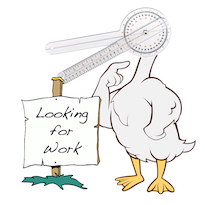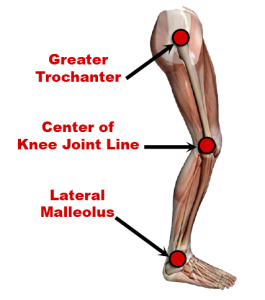More and more indoor cycling instructors come to class equipped with goniometers. But are they really helpful? Are instructors using them correctly? Many instructors do not know how to use them, and they are not as helpful as you think.
A goniometer is an instrument used to measure angles. Physical therapists use goniometers to measure joint angles to assess mobility and range of motion. A properly trained bike fitter will use a goniometer to assess multiple joints throughout the upper and lower body to establish proper alignment and optimal alignment for comfort, efficiency, and power production. Indoor cycling instructors can use a goniometer to assess the angle of the knee joint and make adjustments to a rider’s saddle height. Unfortunately, I’ve witnessed too many instructors using a goniometer incorrectly. Here are three mistakes instructors can make.
Landmarks
When measuring the angle of the knee with the foot at the bottom of the pedal stroke (6 o’clock), the greater trochanter, center of the knee joint line, and the lateral malleolus (ankle bone) should be used. The center of the knee joint and lateral malleolus are fairly easy landmarks to find. The greater trochanter, on the other hand, is located just above to the center of the hip area and usually requires one to touch (palpate) the hip. The greater trochanter of a fit person with minimal body fat is often located with a slight poke, while locating the same bony process of a person who is overweight can lean toward an embarrassing, seemingly inappropriate exploration. Since the arms of the more common and affordable goniometers are only between 6” and 12”, they are not remotely long enough to reach the landmarks needed. So guesswork and visual wizardry come into play. Considering the landmark trifecta: (1) knowing the landmarks, (2) finding the landmarks, and (3) existence of visual landmark wizardry, the goniometer is reduced to a highly adjustable boomerang.
Sitting Incorrectly
Providing one overcomes the above landmark challenge, the angles being measured are only truly useful if the rider is sitting in the saddle correctly. I’m planning on writing an article devoted to proper saddle alignment and position (yes, there is enough to say about this to easily warrant an entire article), but for now I’m just going to say enough to make my point. If a person is seated too far back, too far forward, or tilted incorrectly, the angles measured by the goniometer will be skewed. One might think, “Well, we are still measuring the angle the rider is achieving.” The problem often arises when the rider continues to move around in the saddle because it is uncomfortable and ineffective for generating power or endurance. This makes trying to establish a consistent measurement a moving target and ineffective for assessing saddle height.
Used to Measure, NOT Manipulate, Saddle Height
The biggest mistake instructors make is using the goniometer to dictate proper saddle height. Due to myriad factors, including flexibility, mobility, injury, and stability, the proper angle of the knee with the foot at the bottom of the pedal stroke (6 o’clock), can range from 135 to 172 degrees. That is quite a range. I’ve witnessed instructors attempting to force a rider into a higher saddle position because they measured 155 degrees and thought 165 degrees would be better. Each rider has their own healthy range of motion (due to the factors mentioned above); the goniometer is ONLY used to measure the optimal angle AFTER saddle height has been determined and NOT to prompt adjustment because a larger angle is thought to be better. Trying to influence a rider to change their position based on a number, instead of their body’s ability, is extremely dangerous and should never be done.
Should I Chuck My Goniometer in the Trash?
No. I believe the goniometer is great for creating a visual for the rider. For example, if you believe the rider is sitting too low and they seem reluctant to change, you can measure their knee angle and show them how it looks. As you show them their knee angle, start to expand the goniomter slowly, indicating how you would like to try extending their leg for greater power, muscular endurance, and overall joint health. Most people want to “look good” when riding. If you show them how they may not be looking their best on the bike, they are more likely to allow you to make that needed adjustment. Whatever you do, do NOT tell them their knee angle. You will then start a highly dangerous competition as each person will try to obtain a better number than the next. Trust me on this. I’ve seen it happen.



I too would like clarification on numbers for the angle at the knee. I also purchased the goniometer from Bike Fit. I understand that when one measures from the knee to the center of ankle bone it appears the knee is in deeper flexion then if one measured from the knee straight down perpendicular to the pedal (closer to that 10 degree value Lew spoke of). I still dont see how one could get a range of 35-72?
Lew and Jennifer, I made ONE big error. I made this ONE error 4 times. The angles in the article should have read: 135, 172, 155 respectively. Sorry for the confusion. I must have been lacking my java.
Tom – I have always been taught that on road bikes, you want approximately a 10-degree angle at the knee when the leg is fully extended on the down stroke. We must be talking about different measurement points? Or, having now looked at a protractor, when I say ten degrees I meant the “reverse angle” of 170 degrees. Looking at the illustration with your article, if you use the Center of Knee Joint/Lateral Malleolus line as the base line, the angle from the Knee Joint to the Greater Trochanter appears to be about 170 degrees. I knew I should have paid more attention in High School math classes.
The old plumb bob, dropped from the notch below the rider’s knee to check alignment with the pedal axle (KOPS = Knee Over Pedal Spindle), is still a great way to check and adjust fore/aft seat position.
Lew, I totally agree.
Tom, thanks for the helpful article — I can’t wait for the saddle alignment article too! One thing: in Paul Swift’s ICA Summit lecture last year, he touted the Goniometer and linked to it with a special ICA 40% off deal, so I went out and purchased it. Their Bike Fit goniometer comes with a little “blue” band of 27 to 37 degrees that, according to the instruction sheet that comes with it, is supposed to represent the optimal knee angle for riders. I totally get the point about potential inaccuracy coming from not finding the three correct points to measure knee angle. But assuming that we can find the right points (meaning taking that variable out of the equation), I am curious about whether the 27-37 degree band is NOT something we should be using regularly, and if so, under what circumstances and how do we get riders to the “right” place?
Hey Tony, my experience is a 10% range (blue band) is too small. If riders are without injuries, have good flexibility, well-conditioned leg muscles, and strong core, a 10% range is ideal. However, 80% of the riders I’ve fit over the last 16 years haven been recreational to amateur. They arrive with a whole host of issues, all of which, can impact their pedal mechanics, flexibility, and mobility. The body must always dictate.
Thank you Tom. You’ve cleared up a number of questions. I’ve been using a plumb bob for years now, and have found it very useful. I’m not sure if from what you say in the article that a goniometer would be a worthwhile addition. I will keep learning about it.